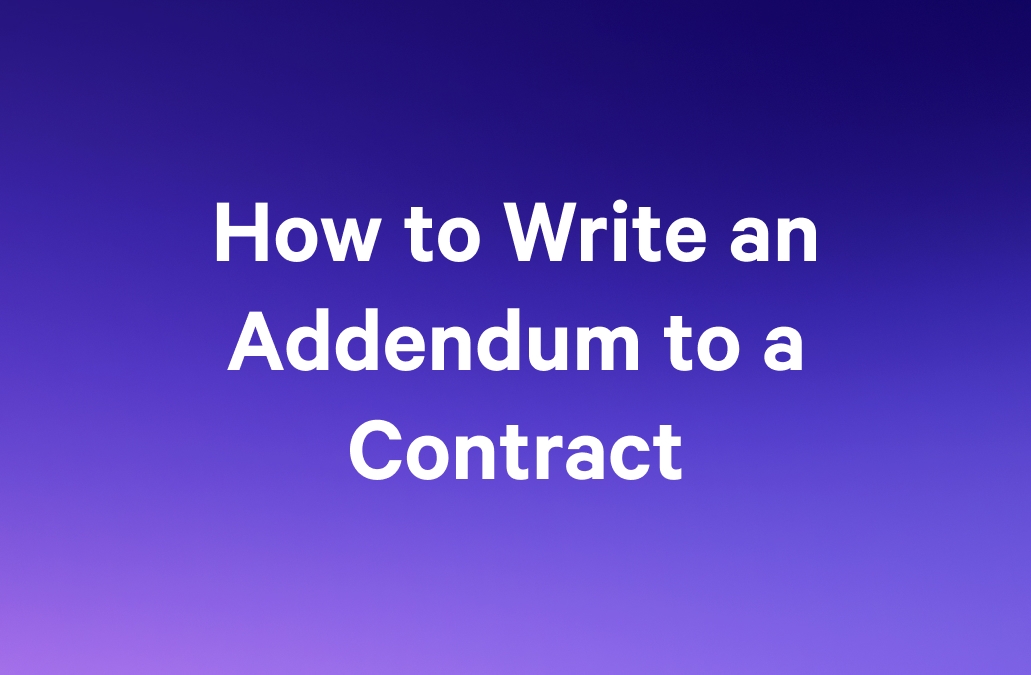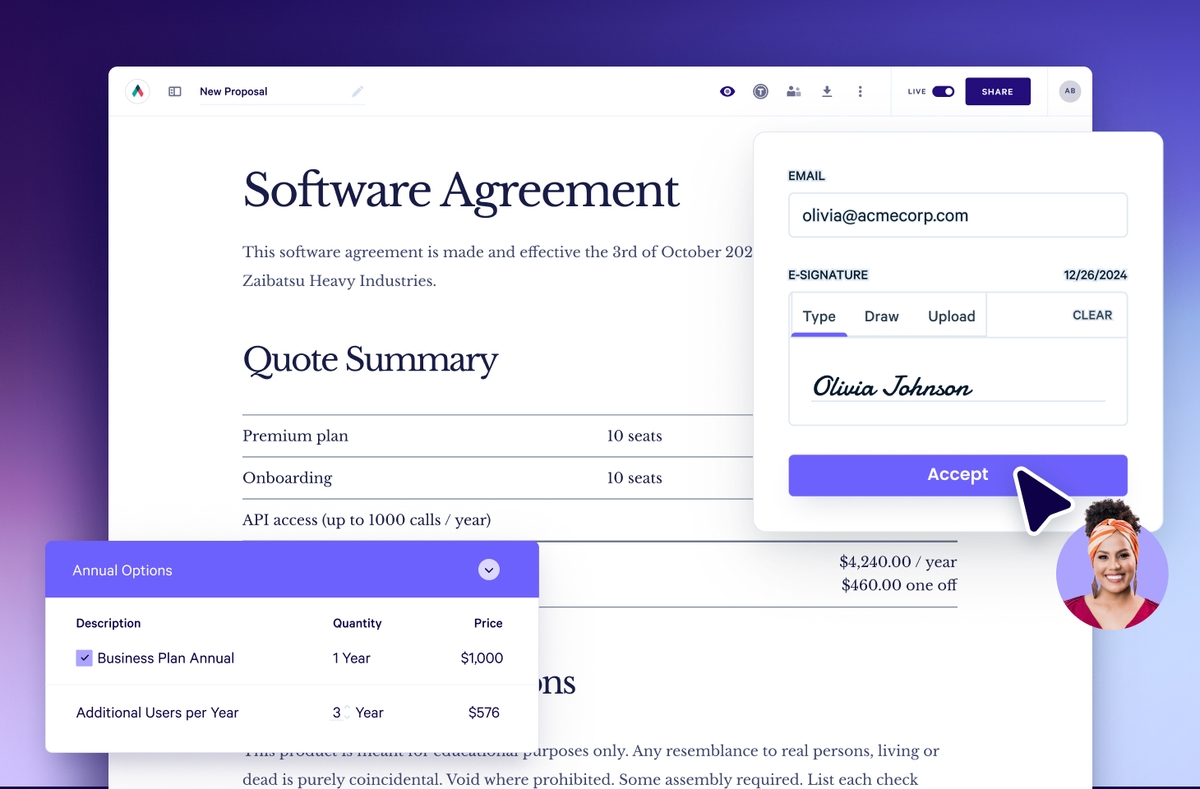Building your dream project in the construction industry shouldn't turn into a nightmare of disputes and legal battles. Yet without proper documentation, even the simplest construction job can spiral into costly delays, safety risks, and blame games.
Delays bleed your budget, safety slips with quality issues, and drawn-out disputes devour your time and money.
A solid construction contract agreement doesn’t just protect your investment—it sets clear expectations, prevents misunderstandings, and ensures everyone stays accountable from day one. In this guide, you’ll learn everything you need to know to create an agreement that keeps your project on solid ground.
Key Takeaways
- A well-drafted construction contract is your project's rulebook, preventing disputes and protecting your investment by clearly defining responsibilities, quality standards, and procedures.
- Choosing the right contract type (lump sum, cost-plus, GMP, etc.) significantly impacts risk allocation, payment structure, and overall project control.
- Essential contract elements include a detailed scope of work, payment terms, change order procedures, timelines, and dispute resolution mechanisms.
- Professional templates and digital tools like Qwilr can streamline the contract creation process while ensuring all crucial elements are included and easily accessible to all parties.
What is a construction contract?
A construction contract is a legally binding agreement that lays out the responsibilities, expectations, and procedures for everyone involved in a building project.
It’s the project's rulebook that defines the scope, timeline, payment terms, and quality standards. It also ensures that risks—like delays, cost overruns, or unexpected site issues—are shared fairly among owners, contractors, and subcontractors.
Unlike casual agreements, these contracts tackle industry-specific challenges—think unexpected site conditions, mid-project design changes, or ensuring materials meet exact specifications.
Why do you need a construction contract?
Without this essential safeguard, you risk misunderstandings, runaway costs, and potential exploitation.
It locks in accountability by spelling out who’s responsible for what, when it needs to happen, and how much it will cost, shielding your investment from costly surprises.
Most importantly, it acts as your legal safety net and offers clear paths for resolving disputes and helping you avoid expensive, drawn-out litigation.
Whether you're a property owner, contractor, or subcontractor, this document converts verbal promises into enforceable commitments while providing a reference point throughout the project's lifecycle—from initial groundbreaking to final inspection and payment.
Types of construction contracts
Construction contracts come in various forms, each with distinct risk allocations and payment structures for different project scenarios. Choosing the wrong contract type can derail your project, leading to budget overruns, unexpected liabilities, and loss of control.
The right contract format aligns with your project needs, budgetary constraints, and risk tolerance while establishing appropriate incentives for quality and timeliness.
Lump sum contract
A lump sum contract proposal locks in a fixed total price for all construction work, materials, and services—like agreeing to pay a flat rate for a home renovation, no matter what surprises come up.
The contractor receives this predetermined amount regardless of actual costs incurred throughout the project.
Why does this matter? It provides budget certainty for owners needing to secure financing or maintain strict financial controls.
Best suited for well-defined projects with complete drawings and specifications, lump sum agreements shine when scope changes are unlikely. Here, most financial risk falls on the contractor, who must cover overruns, delays, or rising material costs out of pocket.
To cover unexpected costs, contractors often pad their bids with contingency buffers—meaning you might pay extra for the peace of mind that comes with a fixed price.
Cost-plus contract
In contrast to fixed-price deals, cost-plus contracts offer full transparency—the owner pays actual direct costs plus a fixed fee or percentage for the contractor to provide construction services.
This approach demands hands-on management, with owners needing to review invoices and track spending to stay on budget regularly.
Cost-plus structures prove invaluable when project scope contains significant unknowns or requires flexibility—like renovation projects with hidden conditions or fast-tracked construction where design evolves alongside the building.
Since their profit isn’t tied to cutting costs, contractors in cost-plus agreements are free to focus on quality craftsmanship—unlike lump sum deals, where staying under budget might mean cutting corners.
Owners may save since contractors don’t need to inflate estimates for unforeseen issues.
The downside? You'll need time and expertise to monitor costs and a well-drafted contract to prevent overruns—making this model best for experienced owners who prioritize flexibility and quality over strict budget certainty.
Unit-price contract
Unit-price contracts calculate payments based on measurable quantities, such as $X per cubic yard of excavation or $Y per linear foot of piping. Much like ordering flooring by the square foot.
This flexible approach is ideal for projects where exact quantities aren’t clear until work is underway—think large-scale infrastructure, earthworks, or utility installations where hidden subsurface surprises are common.
You pay only for what's built rather than estimates. Both parties agree on unit rates upfront, then measure completed quantities to determine final payment.
Contractors benefit from the flexibility to adjust for quantity changes, while owners avoid the risk of overpaying based on speculative estimates. However, meticulous field verification is crucial—measurement disputes can quickly escalate, leading to delays and added costs.
Time and materials contract
Under a Time and Materials (T&M) contract, you pay for actual hours worked plus material costs, with markup percentages for profit. This flexible structure is perfect for projects with shifting requirements or those that need to start immediately, even when the full scope isn’t yet clear.
Unlike fixed-price agreements, T&M contracts adapt to evolving requirements without complicated change orders.
The catch? Without strict oversight, costs can spiral fast—so owners should set a clear spending cap and require regular budget updates to stay in control.
T&M contracts shine for emergency repairs, renovation projects where surprises lurk behind walls, or complex builds where designs evolve alongside construction.
Guaranteed maximum price (GMP) contracts
GMP sales contracts combine budget stability with flexibility. They set a maximum price cap while allowing owners to share in any cost savings if the construction project comes in under budget. The contractor takes full responsibility for managing subcontractors and absorbs costs exceeding the GMP threshold.
This approach creates collaborative incentives while providing owners with budget certainty. The contractor manages all subcontractor relationships and handles cost overruns beyond the GMP threshold.
GMP contracts are ideal for fast-tracked projects, where construction begins before the final design is complete. They offer transparency through open-book accounting practices and typically include detailed cost breakdowns.
For complex projects with evolving requirements, GMP contracts protect owners from unlimited spending while rewarding efficient project execution.
What to include in a construction contract
A solid construction contract spells out who's doing what, when it needs to be done, and how much it'll cost. The sections below walk you through the must-have elements when you’re writing a contract for construction. These elements keep your project running smoothly and help prevent those "but I thought you meant..." conversations down the road.
Scope of work
The scope of work details exactly what will (and won't) be built, from materials and measurements to quality standards and specific deliverables. This section prevents costly misunderstandings—and potential legal disputes—by ensuring everyone shares the same detailed vision for the project.
Include:
- Detailed specifications
- Relevant drawings
- Material brands
- Finish grades
A comprehensive scope provides the benchmark against which all work will be measured and serves as your first line of defense against scope creep.
Payment terms and retainage
Your payment terms should spell out how progress payments are structured, when they're due, and what happens if payment is late. Good payment terms protect both sides from cash flow surprises.
Consider tying payments to project milestones, such as pouring the foundation or completing framing, rather than arbitrary calendar dates, ensuring payments reflect actual progress.
Retainage—holding back 5-10% of each payment—creates a powerful incentive for contractors to complete final punch list items to your satisfaction. This creates motivation to finish those last punch list items properly. Specify exactly when retainage gets released and what conditions must be met first.
Timeline and milestones
Every project needs a realistic, well-structured timeline. Without one, delays and scheduling conflicts can quickly lead to budget overruns and missed deadlines.
A well-crafted timeline creates accountability, helps coordinate subcontractors, and ensures materials arrive when needed, preventing costly downtime.
Your timeline section should include:
- Specific milestone dates for foundation completion
- Framing
- Mechanical rough-ins
- Inspections
- Final completion
Pro tip: Always build buffer periods for material shortages, weather delays, and other unforeseen circumstances. They’re more common than you think and can save your timeline from unexpected setbacks. Include consequences for missed deadlines (like liquidated damages) and procedures for timeline extensions when circumstances change.
Change order process
Let's face it—it’s rare for construction projects to stick perfectly to the plan. That's where a clear change order process saves the day. This section outlines how modifications to the original contract get handled, documented, and priced.
A good change order process requires written authorization before extra work begins, specifies how costs get calculated and establishes approval timelines. Even minor adjustments can lead to surprise costs, strained relationships, and project delays without a clear change order process.
Include who has the authority to request and approve changes—this prevents random site decisions that blow your budget.
Materials and specifications
This section details the exact materials for your project—consider brand names, model numbers, colors, grades, and performance standards. Good specs eliminate the "I thought you meant the cheap version" problem by clearly documenting quality expectations.
Include substitution procedures when specified materials aren't available, and clarify who approves alternatives. Reference applicable building codes and industry standards for major components like HVAC systems or structural elements.
The more detailed your materials list, the less room for misinterpretation. Don't assume contractors know which cabinet hardware or light fixtures you want without spelling it out here.
Insurance, liability, and indemnification
This section protects everyone from the risks involved when things go sideways. It specifies what insurance policies contractors must maintain (like general liability and workers' comp) and at what coverage amounts.
Beyond insurance requirements, it clarifies who's responsible for various risks and under what circumstances. A solid indemnification clause shields you from third-party claims from the contractor's work.
Don't skip these details—they determine who pays when accidents happen or property gets damaged. Request certificates of insurance before work begins and verify policies remain active throughout construction. This seemingly boring paperwork becomes incredibly valuable when unexpected problems arise.
Regulatory compliance and permits
Who handles the paperwork maze of building permits, inspections, and code compliance?
Assign responsibility for obtaining permits, scheduling inspections, and ensuring all work meets local regulations. Spell out which party pays permit fees and penalties for violations.
Also, address environmental requirements, worker safety protocols, and specialty certifications for particular trades. Getting this right prevents work stoppages, costly fines, and potential legal headaches that can derail your timeline.
Warranty provisions
These clauses define the duration of the contractor’s responsibility for their work. Clear warranty language explains what's covered (defective workmanship, material failures) and what's not (normal wear, owner damage).
Include response timeframes for warranty claims and whether emergency repairs get reimbursed if the contractor can't respond quickly.
The strongest provisions require contractors to honor manufacturers' warranties and pass along all warranty documentation at project completion.
Dispute resolution and termination clauses
Nobody starts a project expecting things to go sideways, but when one party faces issues with time spent or successful completion, you need to plan for rough patches.
Disputes can drain time, money, and relationships—this section outlines clear steps for resolving issues before they spiral into expensive legal battles.
Termination clauses define when and how either party can exit the agreement, what notice is required, and how final payment gets calculated. Address what happens to on-site materials, incomplete work, and who owns plans and permits after termination. These provisions act as your escape hatch when problems become unresolvable.
Construction contract template
Need a ready-to-use foundation for your agreement?
As a proposal software, Qwilr’s customizable construction proposal template saves time by including all essential elements upfront.
Simply adjust project specifics, pricing, and timelines using our straightforward editor. Then, include a plain text and formal agreement to cover all the important legal details.
Qwilr enhances your contract process with interactive proposals that help close deals faster. Track client engagement with detailed sales content analytics showing which sections receive the most attention to reveal stakeholder priorities and concerns.

5 tips on writing a construction contract
Writing a solid construction contract doesn’t require a law degree, but overlooking key details can lead to costly disputes and unfinished work.
Whether you're a contractor or property owner, these five tips will help you develop an agreement that protects your interests and sets the project up for success.
- Start with a proven template, but customize it for your specific project. Never use generic contracts without reviewing every clause to ensure it fits your unique situation. Tailoring your agreement to address project-specific concerns prevents coverage gaps that could expose you.
- Write clearly and avoid ambiguous language that could be interpreted in multiple ways. Replace vague terms like "timely manner" or "industry standard" with specific timeframes and measurable quality benchmarks. Precision in language prevents disputes by eliminating room for conflicting interpretations.
- Structure the document with clear headings, numbered sections, and a detailed table of contents. Organize related provisions together and use consistent formatting throughout the entire document. Well-structured contracts make information easy to find during the project and serve as effective reference tools when questions arise.
- Have key stakeholders review drafts before finalization to catch overlooked issues. Include project managers, financial officers, and field supervisors in the review process to identify practical concerns from multiple perspectives. Collaborative review strengthens the document by incorporating diverse expertise and anticipating real-world challenges.
- Include definitions for technical terms and industry-specific language used throughout the contract. Create a dedicated definitions section that explains specialized vocabulary and establishes consistent meaning. Clear definitions prevent misunderstandings and ensure all parties interpret terminology identically throughout the project lifecycle.
Get your construction contract right the first time
Ready to create construction contracts that protect your interests while moving projects forward smoothly?
Qwilr helps you build professional agreements without the legal headaches. Our interactive proposal templates include all essential elements, allow easy customization, and the addition of plain-text agreements and e-signature capabilities for faster approvals.
Don’t let paperwork delay your project or expose you to costly mistakes. Try Qwilr free today and build contracts that protect your investment and keep your project running smoothly.
About the author

Kiran Shahid|Content Marketing Strategist
Kiran is a content marketing strategist with over nine years of experience creating research-driven content for B2B SaaS companies like HubSpot, Sprout Social, and Zapier. Her expertise in SEO, in-depth research, and data analysis allow her to create thought leadership for topics like AI, sales, productivity, content marketing, and ecommerce. When not writing, you can find her trying new foods and booking her next travel adventure."


